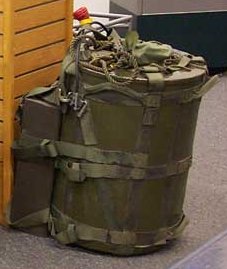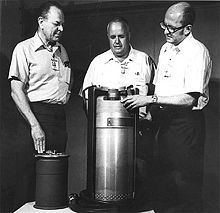Atomic demolition munition
This article needs additional citations for verification. (January 2011) |

Atomic demolition munitions (ADMs), colloquially known as nuclear land mines, are small nuclear explosive devices. ADMs were developed for both military and civilian purposes. As weapons, they were designed to be exploded in the forward battle area, in order to block or channel enemy forces. Non-militarily, they were designed for demolition, mining or earthmoving. However, apart from testing, they have never been used for either purpose.
Military uses
Instead of being delivered to the target by missiles, rockets, or artillery shells, ADMs were intended to be emplaced by soldiers. Due to their relatively small size and light weight, ADMs could be emplaced by military engineers or Special Forces teams, then detonated on command or by timer to create massive obstructions. By destroying key terrain features or choke points such as bridges, dams, mountain passes and tunnels, ADMs could block the movement of enemy forces or channel them into prepared killing zones.[1]
According to official accounts, the United States deployed ADMs overseas in Italy and West Germany during the Cold War.[2][3][4] Recent scholarship also indicates that the most modern types (SADM and MADM) were deployed in South Korea.[5][6][7]
Civilian uses
ADMs have never been used commercially, although such devices have been used to put out gas-well fires as part of the Soviet test program.
The Soviet Union tested the use of nuclear devices for mining and natural gas extraction on several occasions starting in the mid-1960s, as part of the Nuclear Explosions for the National Economy program. Tests for similar purposes were carried out in the United States under Operation Plowshare, but due to radioactive contamination caused by the tests, no commercial use was made of the technology. With today's greater concerns over the dangers of radiation, it seems unlikely that nuclear explosives will ever be used for non-military purposes.
United States ADMs
In the 1950s and 1960s, the United States developed several different types of lightweight nuclear devices. The main one was the W54, a cylinder 40 by 60 cm (about 16 by 24 inches) that weighed 68 kg (150 lbs). It was fired by a mechanical timer and had a variable yield equivalent to between 10 tons and 1 kt of TNT. A Field non-variable yield version of the W54 nuclear device (called the "Mk-54 Davy Crockett" warhead for the M-388 Crockett round) was used in the Davy Crockett Weapon System.
- W-7/ADM-B (c. 1954–67)
- T4 ADM (1957–63) gun type
- W30/Tactical Atomic Demolition Munition (1961–66)
- W31/ADM (1960–65)
- W45/Medium Atomic Demolition Munition (1964–84)
- W54/Special Atomic Demolition Munition (1965–89)

TADM
The Mk 30 Mod 1 Tactical Atomic Demolition Munition (TADM) was a portable atomic bomb, consisting of a Mk 30 warhead installed in a X-113 case. The X-113 was 26 inches (66 cm) in diameter and 70 in (178 cm) long, and looked like corrugated culvert pipe. The whole system weighed 840 pounds (381 kg). Production of the TADM started in 1961 and all were removed from stockpile by 1966. A weapons effect test of the TADM was made in the Johnny Boy shot of the Dominic II series. The yield of Johnny Boy was .5 kt.
SADM
The Special Atomic Demolition Munition (SADM) was a family of man-portable nuclear weapons fielded by the US military in the 1960s, but never used in actual combat. The US Army planned to use the weapons in Europe in the event of a Soviet invasion. US Army Engineers would use the weapon to irradiate, destroy, and deny key routes of communication through limited terrain such as the Fulda Gap. Troops were trained to parachute into Soviet occupied western Europe with the SADM and destroy power plants, bridges, and dams.
The weapon was designed to allow one person to parachute from any type of aircraft carrying the weapon package and place it in a harbor or other strategic location that could be accessed from the sea. Another parachutist without a weapon package would follow the first to provide support as needed.
The two-person team would place the weapon package in the target location, set the timer, and swim out into the ocean where they would be retrieved by a submarine or a high-speed surface water craft.
MADM

The Medium Atomic Demolition Munition (MADM) was a tactical nuclear weapon developed by the United States during the Cold War. They were designed to be used as nuclear land mines and for other tactical purposes, with a relatively low explosive yield from a W45 warhead, between 1 and 15 kilotons. Each MADM weighted around 400 lb (181 kg) total. They were produced between 1965 and 1986.[8]
See also
References
- ^ Employment of Atomic Demolition Munitions (field manual), Washington, DC, US: Department of the Army, 1984, 5-106
{{citation}}: Unknown parameter|month=ignored (help) (unclassified). - ^ Condit, Kenneth W (1992), The History of the Joint Chiefs of Staff—The Joint Chiefs of Staff and National Policy, vol. VI, 1955–56, Washington, DC, US: GPO, p. 146.
- ^ US Security Issues in Europe, 93rd Congress, December 2, 1973, p. 15.
- ^ The New York Times, pp. 1, 34, December 2, 1973
{{citation}}: Missing or empty|title=(help). - ^ Hayes, Peter (1991), Pacific Powderkeg: American Nuclear Dilemmas in Korea (PDF), Lexington, Massachusetts, US: DC Heath and Co, p. 48.
- ^ Gervasi, Thomas ‘Tom’ (1986), The Myth of Soviet Nuclear Supremacy, New York, US: Harper & Row, pp. 416–7.
- ^ Arkin, William M; Fieldhouse, Richard W (1985), Nuclear Battlefields: Global Links in the Arms Race, Cambridge: Ballinger, p. 61.
- ^ "Combating WMD Journal". p. 47. Retrieved 1 July 2013.
{{cite web}}: Unknown parameter|deadurl=ignored (|url-status=suggested) (help)
External links
- SADM Delivery by Parachutist/Swimmer (Special Atomic Demolition Munition) (MPEG) (Film Clip), US: DoE
- Declassified U.S. Nuclear Test Film #31, YouTube
- "SADM", Cold war nuclear weapons (image), 3AD.
- 567th ADM.
- Atomic Demolition Munitions, Brook.
